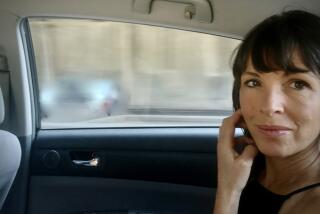CalArts Teacher’s Compilation Speaks Volumes About Women and the Writing Process
At 5, Janet Sternburg found verbal expression too confining. She asked her parents for a pen.
She wrote down her impressions of the movie “Fantasia.” When her urge to create was satisfied, she returned to childhood.
The urge always came back. And now, in its latest revival, Sternburg, a CalArts creative writing teacher, has compiled a series of essays by women writers titled “The Writer on Her Work, Volume II.”
In Volume I, published in 1980, Sternburg, with help from such prominent contemporary authors as Alice Walker, Joan Didion and Anne Tyler, examined the burgeoning revolution of women writers discovering their artistic voices and trying to raise children at the same time.
In Volume II, commissioned essays from 20 authors, Sternburg, who is in her 40s, discovered that women have coped pretty well. The revolution is history.
“Women aren’t trying to become anymore; they already are. And without that struggle, they have time to look around and see so much more to write about.”
Sternburg had been asked for years to produce a second volume. She held out until the landscape had changed enough.
Soliciting contributions from Margaret Atwood, Harriet Doerr and Kaye Gibbons, among others, Sternburg maintains that the work of women writers is flourishing more than ever. In her introduction, she writes: “I found writers looking outward. . . . Women are telling more expansive narratives, from different perspectives, about their engagement with the new territory that is the world.”
Her fascination with women writers is easy to understand--she’s one of them, having written essays and poems.
Her first book didn’t result from ingenuity; it came from necessity. She wrote it because she wanted to read it. Sternburg had begun corresponding with poet Patricia Hampl and other writers, and felt that their dialogue symbolized the conflicts and challenges facing women in a profession previously dominated by men.
“It was happening to me and other people,” Sternburg said. “I thought there must be a book about it. I went to a bookstore, but it didn’t exist. We had a big chunk of literature missing--the accounts of the creative process by women.”
Because of their fragile position as artists and their child-rearing responsibilities, Sternburg said, women in the 1970s held conversations that were very different from men’s.
“There are moments for any group of people to discover themselves,” she said, “and that was their moment.”
In Volume II, women clearly haven’t forgotten their moment and how difficult it was to balance their lives. Maxine Kumin, who received the Pulitzer Prize for poetry in 1973 after writing “Up Country,” recalled a day when she had ordered her children into separate rooms so she could write. An envelope from one of her kids was pushed under her door.
“Dear Mrs. Kumin,” it said. “I think your stories are awful and your poems are worse. I hope they never sell. Signed, A Well-Wisher.”
Sternburg has managed her own balancing act, not with children--she doesn’t have any--but with her dual goals of publishing her material and aiding others with their art. Even today, she juggles many responsibilities, from her CalArts teaching job to numerous philanthropic activities. She serves as senior program adviser in media to the Rockefeller Foundation and is married to CalArts President Steven Lavine. She also produced and directed the award-winning PBS film “Virginia Woolf: The Moment Whole.”
But Sternburg seems most concerned with the process of creating words. She believes every writer faces built-in obstacles. She remembers the ones that briefly took her away from writing. After attending college in Connecticut, she moved to New York. She got a job in public television.
“I wasn’t sure whether I was writing for myself or to fulfill other people’s expectations,” she said.
Working in television gave her an opportunity to break away from old habits. Seclusion had become too familiar.
“I wasn’t sitting alone in a room anymore,” she said.
Still, she believes that a solitary background is almost essential to mold writers. By not exactly fitting in with the rest of society, Sternburg reasons, “there’s some degree of turning inward, which makes you find something in your own world.”
Sternburg went to great lengths to make certain authors submitted heartfelt reflections and that they “didn’t just do a piece for me.” In numerous cases, she had the writers, who were much more famous than she, do rewrites.
Doerr, who won a National Book Award for her first novel, “Stones for Ibarra,” appreciated the chance to share what inspires her.
“Essays are hard, and I had to struggle with it,” said Doerr, who lives in Pasadena, “but whatever one can say that helps other writers is great.”
Sternburg, to demonstrate that the project was truly a collaboration, is sharing the book’s royalties with the 20 contributors. She gets half; they split the rest. She resisted any temptation to include her own essay about the creative process, though she did write an introduction.
“The book was not about me being a writer,” she said.
Still, Sternburg is ready to write a short story, yet another way to satisfy the urge that will never go away.
“I’ve never really stopped,” she said.
More to Read
Sign up for our Book Club newsletter
Get the latest news, events and more from the Los Angeles Times Book Club, and help us get L.A. reading and talking.
You may occasionally receive promotional content from the Los Angeles Times.









